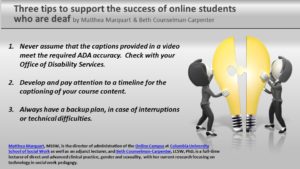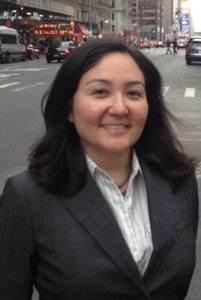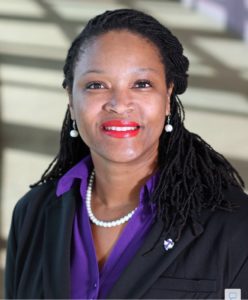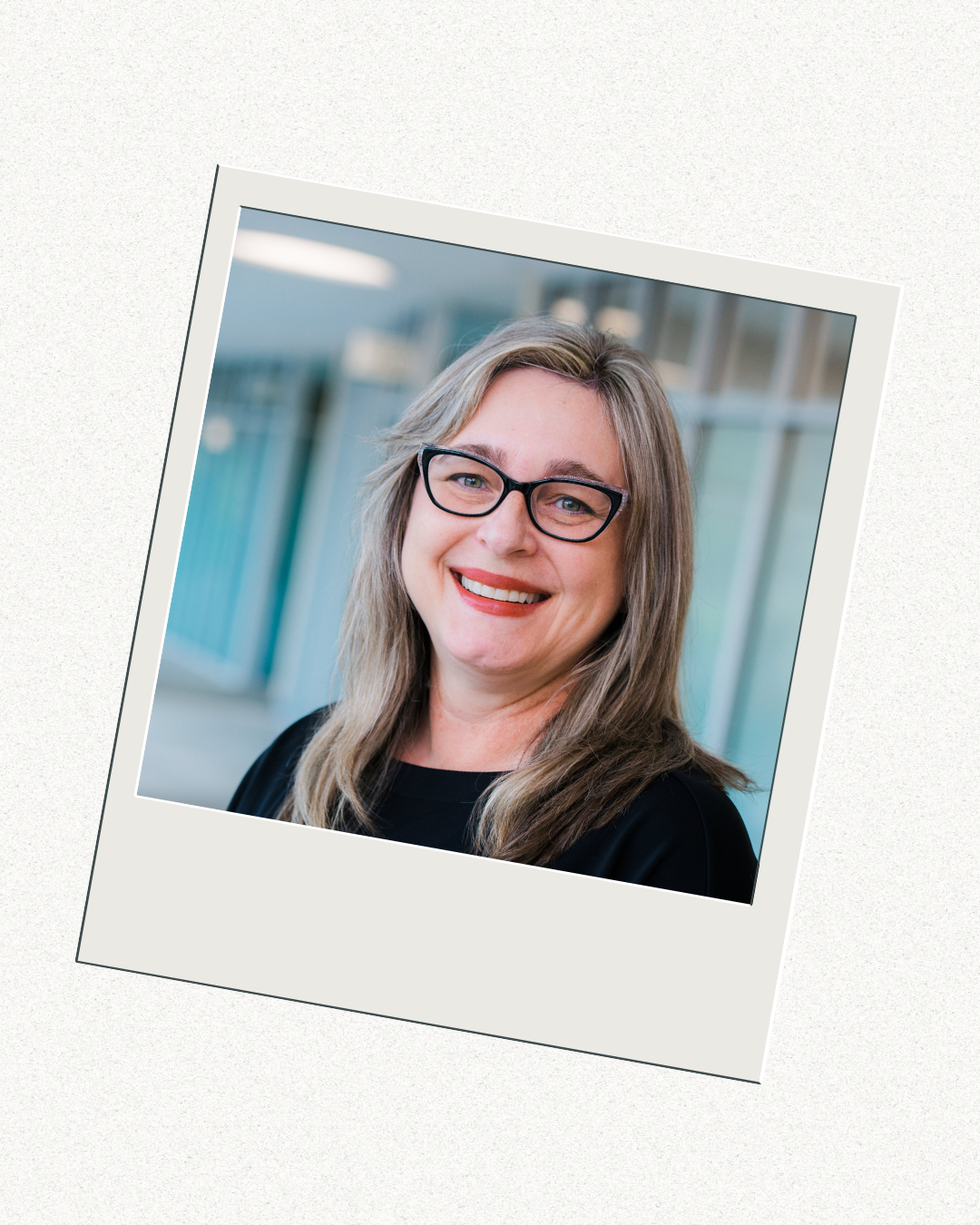Teaching Technology-Mediated Practice in a Clinical MSW Program
 Janet Vizina-Roubal, DSW, MSW, is an Associate Professor of Social Work at Ferris State University in the Department of Social Work. In this blog post, she writes about her inspiration for a technology-mediated practice assignment with MSW students. Assignments like this one will be increasingly valuable for social work students preparing to use technology with clients while meeting professional and ethical practice standards such as the NASW Code of Ethics and the NASW, ABSW, CSWE & ACSW Standards for Technology in Social Work Practice. If you have questions about the assignment, you can reach Dr. Vizina-Roubal on Twitter at @jvizina.
Janet Vizina-Roubal, DSW, MSW, is an Associate Professor of Social Work at Ferris State University in the Department of Social Work. In this blog post, she writes about her inspiration for a technology-mediated practice assignment with MSW students. Assignments like this one will be increasingly valuable for social work students preparing to use technology with clients while meeting professional and ethical practice standards such as the NASW Code of Ethics and the NASW, ABSW, CSWE & ACSW Standards for Technology in Social Work Practice. If you have questions about the assignment, you can reach Dr. Vizina-Roubal on Twitter at @jvizina.
I started teaching my first clinical MSW course the fall of 2014 with excitement and nervousness. With almost eight years of clinical experience in school social work and outpatient therapy, I had a great toolbox of practice tips to share with my students. Adding to the excitement was the idea of creating a technology-based assignment where students could learn and practice technology-enhanced therapy skills. Because I had completed and presented research with a colleague about the benefits of using iPhones in child welfare work, I was curious about how I could create a technology-based assignment for MSW social work students.
Clinical MSW social work classes typically rely on a vast amount of face-to-face role-plays, requiring students to play the part of client and social worker. This experiential learning is challenging, however is very effective at teaching students critical clinical skills. I was interested in stretching this experiential learning process into role-plays for a technology-mediated learning environment, with the goal of helping students learn how to engage with clients via technology-based communication tools. Based on this idea, I worked to structure assignments that would allow students to learn how to use technology within clinical social work. As I embarked on this journey, I searched for curricula or assignments on how to teach online therapy along with best practices. Bewildered, I found almost nothing (Cardenas, Serrano, Flores, & De 2008). I did stumble upon research that showed promising findings that online therapy might be as effective as face-to-face therapy (Chester & Glass, 2006; Dowling & Rickwood, 2013; Holmes & Foster, 2012). This finding legitimized my interest in pursuing this course of instruction and compelled me to develop assignments where students gained experience within online therapy; practicing as the client as well as the therapist.
Supporting the success of online students who are deaf: Lessons presented at #SWDE2017
Matthea Marquart, MSSW, is the director of administration of the Online Campus at Columbia University School of Social Work as well as an adjunct lecturer, and Beth Counselman-Carpenter, LCSW, PhD, is a full-time lecturer of direct and advanced clinical practice, gender and sexuality, with her current research focusing on technology in social work pedagogy. In this blog post, they share highlights from their recent presentation on supporting the success of online students who are deaf. If you have questions for them, they can be reached on Twitter at @MattheaMarquart or @ElisabethAnneCC.
On April 13, 2017, we presented a roundtable session on “Supporting the success of online students who are deaf” at the third annual Social Work Distance Education Conference sponsored by Our Lady of the Lake University’s Worden School of Social Service.
We chose this session topic because social work values, as well as the law, require those of us involved in online education to ensure that we’re providing equal access to all of our students. As the field of online education grows and new technologies develop, it’s important to us to make sure that we’re inclusive in administration, planning, and teaching. We also wanted to host a conversation on the topic, so that we could learn from the experiences of our peers at other institutions.
You can access a copy of our handout, which includes details about the tools & strategies we’ve used to support online students who are deaf, here: https://doi.org/10.7916/D8V12B58
 From our perspective, there are three critical components to success: never assume, attention to a solid time line, and thorough preparation with a back-up plan for live course sessions.
From our perspective, there are three critical components to success: never assume, attention to a solid time line, and thorough preparation with a back-up plan for live course sessions.
Never assume: My experiences (Beth) with deaf and hearing-impaired students over the past year has made me a stronger and more thoughtful instructor. It forced me to actively challenge certain assumptions I had previously held about equal access and thus deepened the creativity in and outside of the classroom to look at access through a more critical lens. When choosing media for your course, never assume that the captions provided are of the level and caliber in terms of accuracy. YouTube videos are NOT equal access compliant, as they are often inaccurate or their timing is off. All media selected by the instructor must be captioned by the institution’s captioning services or be reviewed for accuracy by the Office of Disability Services prior to being assigned, shown or posted. This also includes transcribed videos shown from the library, when transcription has been completed by outside sources, and for podcasts.
Teaching with Infographics: My experiences with digital literacy and non-traditional students
Nathalie P. Jones, PhD, MSW is an Assistant Professor of Social Work at Tarleton State University. In this blog post, Dr. Jones writes about her experiences creating and implementing an infographic assignment with nontraditional social work students.
As an Assistant Professor of Social Work at Tarleton State University, I have absolutely enjoyed educating social work students on the use of technology through macro social work practice courses. I teach a large number of non-traditional learners (those who have been out of school for longer than one year, and are employed, parenting, or in any other roles that are competing with being a learner as defined by the National Center for Education Statistics [2015]). I find that they develop student groups quickly in order to have support while working on assignments, especially those assignments that include the use of digital technology.
To help my students improve their understanding of digital and social technology, I have introduced the use of infographics during an advanced social work course entitled Women’s Issues. Infographics are visual representations of almost any type of information. Infographics are similar to storytelling with visual content and supported with statistical data. They are an effective way to communicate large amounts of information in a clear and succinct way, and are an increasingly popular tool in popular media and the non-profit world (NonProfit Tech for Good, 2014). Understanding how to create, share and evaluate infographics is a key digital literacy skill for social workers (Shelly, 2015). Along with all these benefits, I wanted to create an assignment that was fun and engaging for my nontraditional students who are often nervous about nontraditional, digital assignments.
For the Women’s Issues course, I asked students to research an issue or social problem affecting women, turn that research into an infographic (rather than a written paper), and then share their infographics with professionals outside of the class as a way to network with alliances who advocate on behalf of women. This meant students needed to not only create a quality artifact for a grade, but also learn how to share it with other advocates in a public way – via social media. In an effort to support learners who were experiencing technology in college for the first time, I provided them with seven detailed steps to successfully complete the infographic assignment. These steps involved learning about Twitter as well as creating an infographic.
Here are the assignment steps directly from the course syllabus:
Step 1: Create a Twitter Account & provide your Twitter Handle. *Don’t forget to follow the instructor.
Step 2: Research & provide a resource of two infographics (1) from the web and (1) from Twitter related to Women’s Issues. Then, provide a 1-2 page comparison on how the infographic was distributed, what was learned & why this is a resource for issues related to women.
#APM16 Day 2 – Learning about Poverty through Interprofessional Simulations
 Today I am presenting a poster with Allyson Varley, PhD Student in the UAB School of Public Health and a research/teaching assistant extraordinaire. Our work focuses on why and how we started implementing poverty simulations with students from diverse majors and professional programs across our campus. Poverty simulations are increasingly common in higher education, offering an innovative modality to increase students’ understanding of poverty. The simulation enables participants to view poverty from different angles in an experiential setting. The poster will cover implementation of poverty simulations and present preliminary findings on the learning outcomes for students. Other member of our working group were not able to join us at #APM16, Drs. Dawn Talyor Peterson, Sallie Shipman, Laura Debiasi and Marjorie Lee White.
Today I am presenting a poster with Allyson Varley, PhD Student in the UAB School of Public Health and a research/teaching assistant extraordinaire. Our work focuses on why and how we started implementing poverty simulations with students from diverse majors and professional programs across our campus. Poverty simulations are increasingly common in higher education, offering an innovative modality to increase students’ understanding of poverty. The simulation enables participants to view poverty from different angles in an experiential setting. The poster will cover implementation of poverty simulations and present preliminary findings on the learning outcomes for students. Other member of our working group were not able to join us at #APM16, Drs. Dawn Talyor Peterson, Sallie Shipman, Laura Debiasi and Marjorie Lee White.
Poverty simulations are increasingly common in higher education, offering an innovative modality to increase students’ understanding of poverty. The simulation enables participants to view poverty from different angles in an experiential setting. The poster will cover implementation of poverty simulations and present preliminary findings on the learning outcomes for students.





